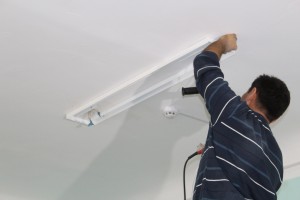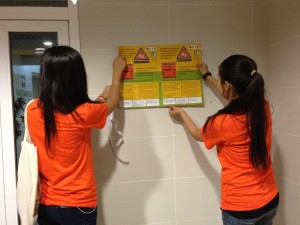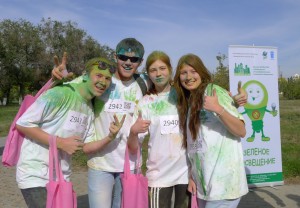 ASTANA – With lighting expected to grow from 13 percent of Kazakhstan’s energy consumption today to 36 percent by 2015, the country is looking for energy efficient lighting solutions. The Ministry of Industry and New Technologies of Kazakhstan and the United Nations Development Programme’s Global Environmental Facility (GEF) are working together on a project, “Promotion of Energy-Efficient Lighting in Kazakhstan,” to develop electric energy, improve energy efficiency and promote energy saving. The project aims to transform the lighting market in Kazakhstan and gradually replace outdated and inefficient lighting systems.
ASTANA – With lighting expected to grow from 13 percent of Kazakhstan’s energy consumption today to 36 percent by 2015, the country is looking for energy efficient lighting solutions. The Ministry of Industry and New Technologies of Kazakhstan and the United Nations Development Programme’s Global Environmental Facility (GEF) are working together on a project, “Promotion of Energy-Efficient Lighting in Kazakhstan,” to develop electric energy, improve energy efficiency and promote energy saving. The project aims to transform the lighting market in Kazakhstan and gradually replace outdated and inefficient lighting systems.
Syrym Nurgaliyev, project manager, and Dinara Tamabayeva, public relations specialist, both from UNDP, spoke with The Astana Times about the project’s goals and its plan for achieving them.
Who initiated the project and why was the project launched in Kazakhstan?
The Ministry of Industry and New Technologies decided that it was necessary to introduce in Kazakhstan all available methods of energy efficiency—renewable energy, modernisation of construction materials, modernisation of systems—and among them was the issue of increasing lighting efficiency. In 2012, the law on withdrawing incandescent lamps from use as non-efficient methods of lighting was adopted. Consequently, we needed to identify what subordinate laws should be amended and what to do in this direction. The ministry asked the UNDP to share worldwide advanced experience and best practices and introduce them here in Kazakhstan.
How will the project function?
The project consists of four components. The first is the implementation and creation of policies and measures introducing energy-efficient lighting. This includes regulatory issues. … The UNDP helps the Ministry of Industry and New Technologies amend laws regarding construction rules and regulations and sanitary rules and norms and adopt new standards. Currently Kazakhstan has light-diode lighting, but we don’t have laws or standards regulating the quality of this product. Currently, we are working with the Committee on Standardisation to introduce minimum quality standards for light-diode lighting. We are also considering issues in utilisation schemes. At the moment, more people are using energy-efficient lamps and we need to show them what to do with them after they burn out because these lamps contain mercury and are very dangerous when not properly used. Within our project, a joint pilot project with the Astana akimat (city administration) was created to promote these schemes of utilisation. The akimat bought containers and we also held an informational campaign [and] filmed a video, which is broadcast on the state TV channels.
The second component is the development of a market for energy-efficient lighting by increasing the access of market participants to energy efficient technologies, which may involve discount and coupon programmes. Within this component, we show the population the advantages of energy-efficient lamps. … This year, we want to hold a comprehensive programme, create a discount programme and introduce pilot events with producers and supermarkets.
The third component is increasing awareness of and interest in energy-efficient lighting among consumers. Within this component we are developing video ads and handouts. We plan to organise big events this year, like campaigns and flash mobs, to increase the level of awareness about energy-efficient lighting.
The fourth component is the launch of a number of pilot projects showing the practical implementation and commercial benefits of the project.
In 2013, we ran a project introducing efficient lighting in schools in the Akmola and East Kazakhstan regions. The akimats provided us with information on schools and co-financed the project, and the effect was very good. … We changed the lighting system in schools there and children could better see the board even from the back desks. The quality of lighting increased. [Chair of the Mazhilis Committee on Social and Cultural Development] Dariga Nazarbayeva took part in the presentation of our pilot project in Vyacheslavskaya school, Akmola region,. … .
Akmola region Akim (Governor) Kosman Aitmukhambetov asked us to provide information about how these innovations correspond to sanitary rules and norms. He plans to introduce such lighting in Kokshetau schools.
This year we plan to work on street lighting. We will show how to illuminate streets; we already have streets lighted with light-diode lighting in Astana. We also choose one regional centre, one small city and one rural area. We don’t take into account Astana and Almaty because these cities are very well lighted.
How do you choose the areas to introduce energy-efficient lighting?
We have certain criteria: we need co-financing, we don’t need modern equipment, … and we also need the support of akimats.
We have a special working group to choose the areas, [which includes] representatives of Kazakhstan’s communal housing services, the Ministry of Environment and Water Resources and the Ministry of Industry and New Technologies.
The project is not only implemented by the UNDP and the Ministry of Industry and New Technologies— as akimats support us a lot. Without the support of akimats, our activities would not work.
Taking into account the example of lighting school, the Ayagus district akimat [in East Kazakhstan region] funded itself lighting of a street children take to go to a local school. Neighbouring districts also saw this positive example and allocated this year the money from the budget funds for this programme.
Who is financing the project?
It is financed by the Global Environmental Facility though the UNDP. When we talk about financing, we mean that we help create institutional frameworks. We could buy lamps, but we believe it’s more efficient to create a system to show how effective they will be. Kazakhstan has its own funds. We need to show where to allocate the funds.
 At what stage is the project right now?
At what stage is the project right now?
We have analysed the existing regulations and what needs to be done in terms of norms and rules and standards and this year we will implement our results. This year, we will introduce eight standards for light-diode lighting … . We are also working with other countries within the Customs Union so our norms can be taken into account in the customs regulations and will be legitimate for all three countries [Kazakhstan, Russia and Belarus]. Two years ago, when we started writing amendments, we had no factories for producing light-diode lamps; currently we have about 18 factories and workshops. This is quickly developing, so we also need to take into account the interests of our producers.
We are creating requirements for the supply of goods because currently there are none regarding lamps—they are just supplied. In order to check the quality, we plan to open a testing laboratory, which will issue certificates.
Who is involved in writing bills?
We have a working group; we’ve hired specialists in this field, experts on sanitary norms and rules. We hire companies that do analysis; we hold tender and the most experienced company wins. The tender system in the UNDP is not based on the lowest price, but according to experience. We also have international best practice experts.
Who controls the introduction of new technologies on the ground?
We monitor the lighting, conduct social research and control the level of lighting.
What will happen once the project is completed?
We plan to create such conditions by 2016 that the work we are doing now will continue without our participation. When the project finishes, it will work in all the spheres. The work will be based on regulatory documents we are elaborating now.

